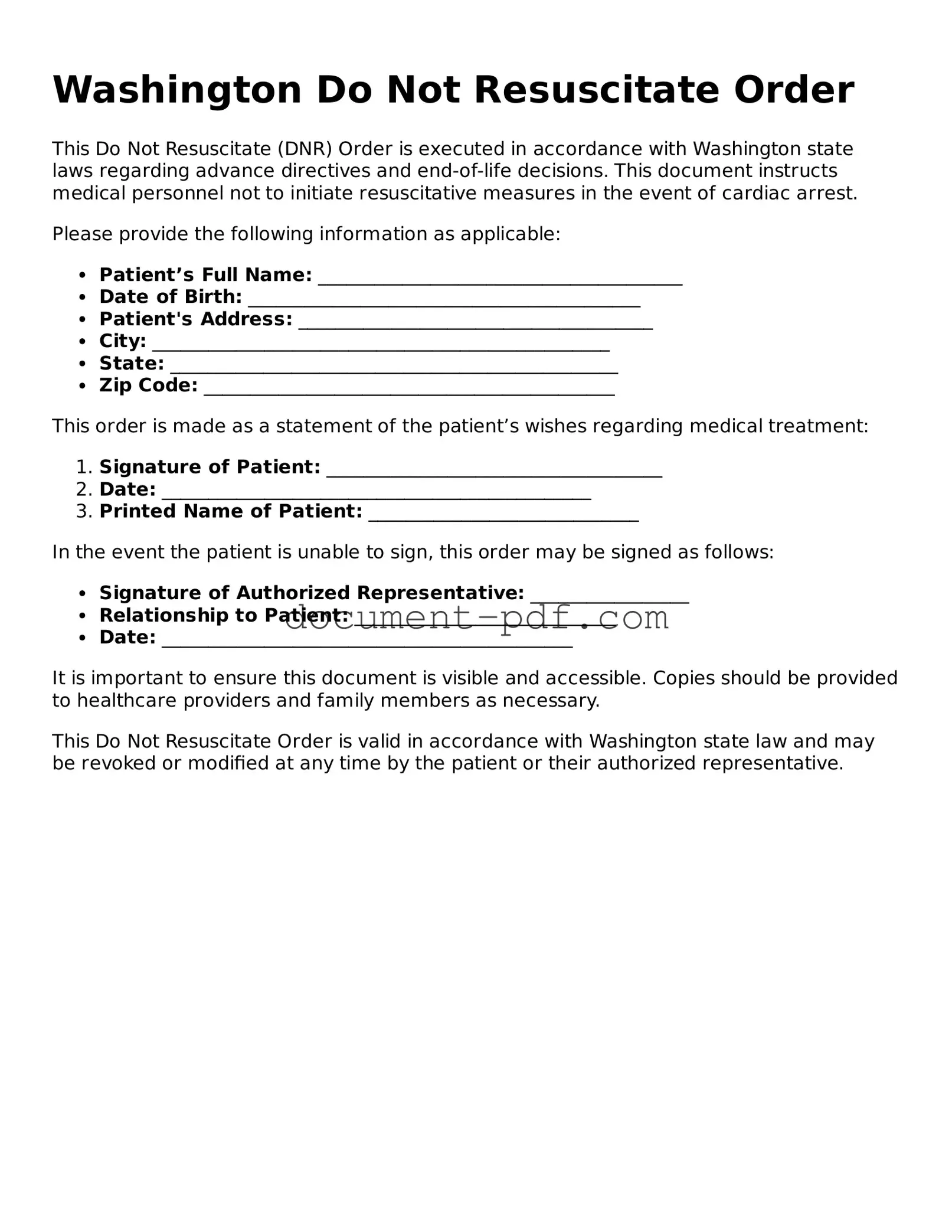The Washington Do Not Resuscitate (DNR) Order form shares similarities with a Living Will. A Living Will is a legal document that outlines a person's preferences regarding medical treatment in the event they become incapacitated. Like the DNR, it allows individuals to express their wishes about life-sustaining treatments, ensuring that their choices are respected even when they cannot communicate them. Both documents empower individuals to make decisions about their own healthcare in advance, promoting autonomy and personal agency in medical situations.
Another document akin to the DNR is the Healthcare Power of Attorney. This legal instrument designates a trusted person to make healthcare decisions on behalf of an individual if they are unable to do so. While the DNR specifically addresses resuscitation efforts, the Healthcare Power of Attorney encompasses a broader range of medical decisions. Together, these documents ensure that a person’s healthcare preferences are honored, whether through direct instructions or by appointing a surrogate decision-maker.
The Physician Orders for Life-Sustaining Treatment (POLST) form is also similar to the DNR. POLST is a medical order that outlines a patient’s preferences for various types of medical interventions, including resuscitation. Unlike the DNR, which is often a standalone document, POLST is intended to be a more comprehensive approach that addresses a wider array of medical treatments. Both forms serve to communicate an individual’s wishes to healthcare providers, ensuring that their preferences are clear and actionable in emergency situations.
Advance Directives are another related document. This term encompasses both Living Wills and Healthcare Powers of Attorney, providing a framework for individuals to express their healthcare preferences. Like the DNR, Advance Directives aim to alleviate the burden on family members and healthcare providers by clearly outlining a person’s wishes. They serve as a crucial tool for ensuring that individuals receive care aligned with their values and desires, particularly in critical moments.
The Do Not Intubate (DNI) order is closely related to the DNR. A DNI specifically instructs healthcare providers not to insert a breathing tube if a patient cannot breathe on their own. While a DNR focuses on resuscitation efforts, a DNI addresses a specific aspect of life-sustaining treatment. Both documents reflect a patient’s desire to limit aggressive medical interventions, emphasizing the importance of comfort and quality of life over invasive procedures.
Another document that bears resemblance to the DNR is the Medical Order for Scope of Treatment (MOST). This form is often used in certain states to provide clear guidance on the level of medical intervention desired by a patient. Similar to the POLST, MOST allows individuals to express their preferences regarding resuscitation and other life-sustaining treatments. It serves as a vital communication tool for healthcare providers, ensuring that patient wishes are honored across various medical settings.
The Comfort Care Order is also comparable to the DNR. This document focuses on providing comfort and palliative care rather than curative treatment. While a DNR explicitly states a refusal of resuscitation efforts, a Comfort Care Order emphasizes the goal of enhancing the quality of life for patients facing terminal conditions. Both documents reflect a patient-centered approach, prioritizing the dignity and comfort of individuals in their final stages of life.
Do Not Hospitalize (DNH) orders are another document that shares similarities with the DNR. A DNH order is used to indicate that a patient does not wish to be admitted to a hospital for treatment, particularly in end-of-life scenarios. While the DNR addresses resuscitation, the DNH focuses on the overall setting of care. Both documents align with a patient’s desire to receive care in a manner that respects their wishes and personal values.
Understanding the intricacies of retirement benefits is essential for NYC employees, particularly when it comes to the application process for their Vested Retirement Benefit. Members in Tier 3 and Tier 4 of the New York City Employees' Retirement System should familiarize themselves with the New York PDF Docs to ensure they complete the necessary NYcers F266 form correctly, as this document is a pivotal part of formalizing their retirement planning after leaving City service.
Finally, the End-of-Life Care Plan is another document that can be compared to the DNR. This comprehensive plan outlines a patient’s preferences for care during their final days, including decisions about resuscitation, pain management, and other treatments. Like the DNR, it emphasizes the importance of aligning medical care with the patient’s values and desires. Both documents serve as vital tools for guiding healthcare providers in delivering compassionate and respectful care at the end of life.
